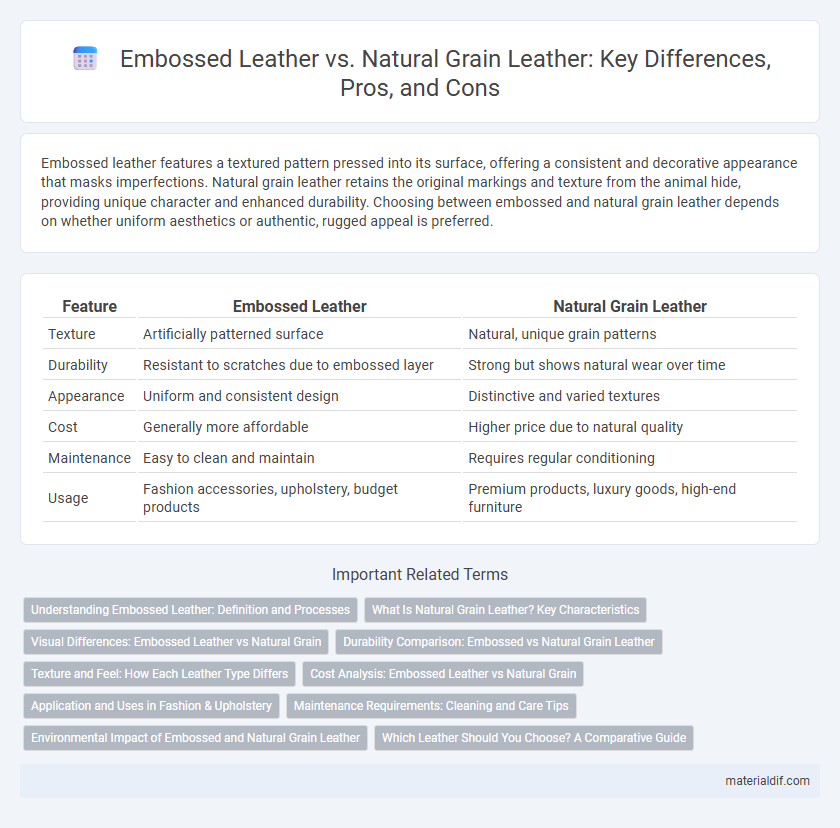Embossed leather features a textured pattern pressed into its surface, offering a consistent and decorative appearance that masks imperfections. Natural grain leather retains the original markings and texture from the animal hide, providing unique character and enhanced durability. Choosing between embossed and natural grain leather depends on whether uniform aesthetics or authentic, rugged appeal is preferred.
Table of Comparison
| Feature | Embossed Leather | Natural Grain Leather |
|---|---|---|
| Texture | Artificially patterned surface | Natural, unique grain patterns |
| Durability | Resistant to scratches due to embossed layer | Strong but shows natural wear over time |
| Appearance | Uniform and consistent design | Distinctive and varied textures |
| Cost | Generally more affordable | Higher price due to natural quality |
| Maintenance | Easy to clean and maintain | Requires regular conditioning |
| Usage | Fashion accessories, upholstery, budget products | Premium products, luxury goods, high-end furniture |
Understanding Embossed Leather: Definition and Processes
Embossed leather is leather that has been mechanically stamped with a pattern or texture to mimic natural grain or create intricate designs, enhancing its aesthetic appeal and uniformity. The embossing process involves pressing heated plates or rollers onto the surface of the leather, which softens the hide and imprints the desired texture, often used to replicate expensive or rare leather grains. This technique allows for greater consistency in appearance and durability compared to natural grain leather, which retains the original, unaltered texture of the animal hide with its unique markings and variations.
What Is Natural Grain Leather? Key Characteristics
Natural grain leather retains the authentic texture and markings of the animal hide, showcasing its original pores, scars, and wrinkles. This type of leather is known for its durability, breathability, and ability to develop a rich patina over time. Unlike embossed leather, natural grain leather offers a unique, irregular surface that enhances both aesthetics and strength.
Visual Differences: Embossed Leather vs Natural Grain
Embossed leather features a uniform, often repetitive texture created by pressing patterns onto the surface, enhancing design consistency and visual appeal. Natural grain leather displays unique, irregular markings and pores, reflecting the hide's original characteristics and adding authenticity. The contrast between embossed and natural grain leather lies in stamped precision versus organic variation, influencing aesthetics and perceived quality.
Durability Comparison: Embossed vs Natural Grain Leather
Embossed leather features a textured surface created by stamping patterns onto a lower-grade hide, which can mask imperfections but often reduces breathability and flexibility compared to natural grain leather. Natural grain leather retains the hide's original surface, offering superior durability and resistance to wear, making it more suitable for long-term use. While embossed leather may resist scratches better initially, natural grain leather generally ages more gracefully, developing a unique patina over time.
Texture and Feel: How Each Leather Type Differs
Embossed leather features a textured surface created by pressing patterns onto the hide, providing a consistent and often more uniform feel compared to natural grain leather. Natural grain leather retains the original surface with its unique markings and variations, resulting in a softer, more supple texture that ages beautifully over time. The tactile experience of embossed leather is more structured and uniform, while natural grain leather offers a richer, more organic feel that reflects the hide's natural characteristics.
Cost Analysis: Embossed Leather vs Natural Grain
Embossed leather typically costs less than natural grain due to its manufacturing process, which involves stamping patterns onto lower-grade hides to mimic the appearance of premium grain. Natural grain leather, sourced from top-quality hides with minimal processing, demands higher prices because of its durability, unique texture, and superior breathability. The cost difference reflects not only material quality but also the longevity and aesthetic appeal inherent in natural grain leather compared to embossed alternatives.
Application and Uses in Fashion & Upholstery
Embossed leather, characterized by its patterned surface created through heat and pressure, is widely used in fashion for handbags, shoes, and accessories due to its diverse design options and cost-effectiveness. Natural grain leather, retaining its original texture and durability, is prized in high-end upholstery and luxury fashion items for its unique aesthetic and long-lasting quality. Both materials serve distinct purposes, with embossed leather offering versatility for trendy, decorative applications, while natural grain leather emphasizes authenticity and premium craftsmanship.
Maintenance Requirements: Cleaning and Care Tips
Embossed leather requires gentle cleaning with a damp cloth and mild soap to maintain its textured pattern without causing damage, while natural grain leather benefits from regular conditioning to preserve its softness and prevent cracking. Both types should be kept away from direct sunlight and excessive moisture to avoid fading and mildew. Using specialized leather cleaners and conditioners tailored to each leather's finish enhances durability and appearance over time.
Environmental Impact of Embossed and Natural Grain Leather
Embossed leather involves pressing patterns onto the surface, often requiring additional chemicals and energy-intensive processes that can increase its environmental footprint compared to natural grain leather. Natural grain leather retains the hide's original texture with minimal treatment, reducing chemical use and waste generation during manufacturing. Choosing natural grain leather supports more sustainable practices by minimizing processing steps and conserving resources.
Which Leather Should You Choose? A Comparative Guide
Embossed leather features a textured pattern stamped onto its surface, offering uniformity and resistance to scratches, while natural grain leather showcases the authentic, unaltered texture of animal hide, prized for its unique character and breathability. Choosing between embossed and natural grain leather depends on your preference for durability and consistent appearance versus originality and natural aging. For applications demanding longevity and easy maintenance, embossed leather is ideal, whereas natural grain leather suits those valuing aesthetic richness and patina development over time.
Embossed leather vs Natural grain Infographic

 materialdif.com
materialdif.com